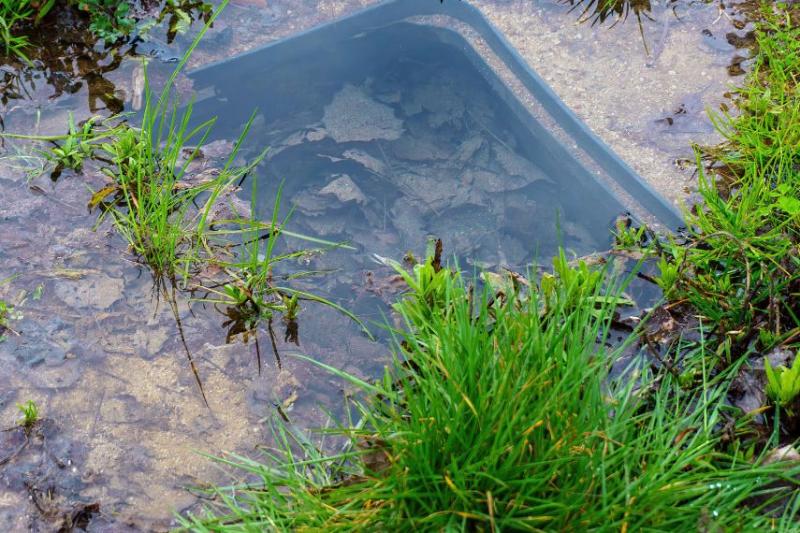
It’s most common for the slimmer pipes around your home to become blocked, like those connected to your toilet or sinks, but outside drains can also become blocked with a build up of debris.
While it’s not a very pleasant job, it may be possible to unblock the drain yourself – so before you call in a professional, try following these steps.
Step 1: Get the right equipment
The right equipment is vital if you’re going to try and unblock a drain yourself.
First and foremost, protective clothing is essential as there’s a chance harmful bacteria may have built up in the blockage. You should wear:
- waterproofs
- gloves
- face and eye covering such as a visor or goggles
Other than protective clothing, you may need a bucket, hose and a drain rod. A drain rod is long, thin, strong and jointed and helps you get right into the blockage to break it up.
They're readily available at most DIY shops, so you should be able to get one easily and without spending too much.
Step 2: Take a look
The first thing to do is try and identify the problem. It may not be straightforward to figure out exactly where the blockage is, so lift the trap drain cover and check:
- Can you see the blockage?
- If you can, can you tell what the blockage is? Is it leaves and silt, fat/oil/grease from cooking, or something else?
- Can you reach the blockage easily?
If you can work out what the blockage is, you’ll be better able to tell if it’s something you can deal with or if you need help from a professional.
Something that can easily be broken apart, like a build up of silt and leaves, would be easier to DIY than a completely solid blockage.
Being able to see and reach the blockage will make it easier to deal with, but you can still clear a blockage you can’t see/reach – it’ll just take a bit more patience and a little guesswork.
If you’re at all unsure how safe or easy it would be to attempt this job yourself, it’s best to leave it to a professional.
Step 3: Clear the part of the blockage you can reach
When you’ve got your equipment together, it’s time for the least pleasant part of the job.
Making sure you’re wearing your protective clothing and you have your bucket handy, reach into the trap drain and clear as much of the blockage as you can.
Doing this will make it easier to clear whatever remains with your drain rod as there will be less debris to push through. If you can’t reach any of the blockage, skip straight to step four.
Step 4: Clear the rest of the blockage
Next you’ll need your drain rod and a bit of patience. Find the nearest manhole cover to your trap drain, lift the cover off and set it aside.
Feed the drain rod into the drain and through the blockage, moving it around to break up the debris. The rod will become easier to move as the blockage disintegrates, so it’s useful to pay attention to that if you can’t actually see the blockage.
Use water from your hose to help flush the debris away. Pouring water down the drain is also helpful if you can’t see the blockage as you’ll see the water level change as the blockage disperses.
And don't forget to put the manhole cover back in place when you've finished.
When to call a professional
If the above didn’t work, or it wasn’t safe to attempt, it’s time to call in a professional.
It could be that the blockage is bigger than you first thought or it’s something solid that can’t be dissolved or broken up. Either way, the pros will be better equipped to deal with it.
Home Emergency cover
Home Emergency or Home Emergency Extra cover will cover a call-out to your home if you have an emergency that causes total failure, to blocked or leaking:
- sinks
- waste pipes
- rainwater drains
- bath, toilet or external drainage (even if you still have another working toilet or bathing facility)
- soil vent pipes (pipes that carry wastewater to the underground drainage system)
You should be eligible for cover as long as the leak can’t be contained, and you’ve reported your home emergency within 48 hours of discovering it.
We can only cover temporary repairs up to the value of £500 per claim for Home Emergency cover and £1,000 for Home Emergency Extra cover.
How can I make a claim?
First, always check your policy details and cover limits before making a claim. You can view them on MyAccount.
If you’re confident your situation is covered, get in touch via our make a claim page or through your MyAccount.
What’s not covered
There’s a few things we can’t provide compensation for. That includes:
- repairs that are the responsibility of the local water authority (even if they’re within the boundaries of your home)
- any regular cleaning or descaling of your drains
- repairing or replacing any part of the drain which is damaged but doesn’t completely block it
How to prevent another blockage
Here are a few tips to stop another blockage happening:
- Keep the area around the drain clear of any debris to prevent it being washed down
- Don’t wash anything solid down the sink or flush any rubbish down the toilet
- Be careful to dispose of any cooking fats or oils properly, and don’t wash them down the drain. If some goes down by accident, follow it up with some hot water to flush it through and hopefully prevent it solidifying in the pipes.
Keeping your gutters clean can also help as this stops leaves and other debris that can collect there potentially being washed down the drain, so take a look at our gutter cleaning tips and advice too.


